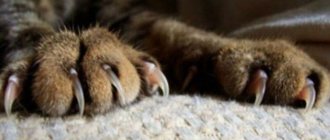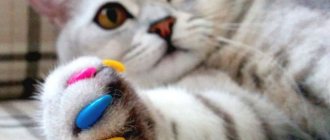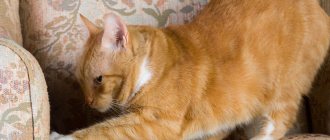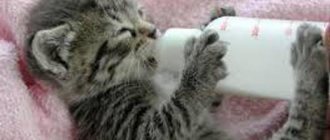The first instinctive reaction in this case is to yell at the cat, shoo it away, or perhaps even spray it with water from a spray bottle.
However, doing any of these steps will not save the furniture.
In fact, yelling at a cat because it is scratching can seriously anger it, cause it stress, and even cause it to behave erratically and fear its owner.
It is a fact that cats will sharpen their claws. Therefore, you should be patient and think about how to protect furniture from a cat. The good news is that cats are easy to train. Additionally, there are surfaces that a cat would rather scratch, even more than furniture.
Effective ways
It is not easy to stop a cat from tearing furniture and wallpaper if it has already become a habit. Some owners prefer to change the type of wall and floor coverings. For example, cats are indifferent to plastic panels, ceramic and PVC tiles, high-class laminate, artificial stone and decorative plaster.
Some people prefer to cover upholstered furniture with thick fabric upholstery.
However, we must understand that even replacing the coating or an alternative to it will not be able to permanently wean the cat from scratching its claws and gnawing objects. This process is natural and vital. Therefore, you will have to not only wean yourself off, but also think about how to switch your attention to other subjects.
Let's consider the most effective methods of protection.
Repellent odors
You can try to wean your pet from a bad habit by treating his favorite scratching areas with a product with an unpleasant aroma. It is known that cats do not like the citrus smell, so this is worth taking advantage of.
This can be orange, lemon peel or essential oil.
However, oil is inconvenient because it leaves unsightly greasy stains on the surface. An alternative to citrus, ether or spray can be some spices (for example, coriander or chili), which can be used to treat some surfaces (not suitable for furniture on which a person sits).
Protective coatings
You can save the upholstery of a sofa and armchairs by using covers made of special fabric or so-called anti-vandal Euro covers. In specialized stores you can choose options with a coating that is too tough for cats and not for their claws.
They simply will not be able to stick their claws into the fabric.
Trimming and nail trims
You can stop your cat from scratching the upholstery and damaging the surface of the wallpaper in a more effective way by cutting the claws or gluing special plastic covers on them. To trim claws, purchase a special device - a nail clipper, literally cutting off 1-1.5 mm of the regrown length.
The device is quite convenient and allows you not to stretch out the procedure, and therefore the cat does not have time to get nervous.
The pads are put directly on the claws, having previously lubricated them inside with special glue. Don't worry too much about it being harmful. As practice shows, the glue is not so strong, but for some time the cat will not be able to damage the furniture upholstery and wallpaper.
Alas, at the same time she will not be able to retract her claws, and it will be difficult for her to jump, but she will still be able to provide temporary protection to objects.
Pulverizers and sprays
To prevent your cat from sharpening its claws and teeth on furniture, wallpaper and curtains, you can try using a spray bottle. Scaring can have an effect on individual individuals if it is done at the moment when the animal is tearing upholstery fabric or wallpaper.
You can also spray your favorite items with a special spray to repel your pet. Citrus-scented sprays are repulsive to some cats.
Available means
You can protect furniture and wallpaper using another method. For example, favorite places can be covered with sticky, sliding or rustling material on top. For example, stick double-sided tape or foil to the torn area of the wall.
Some people prefer to create a scaring noise when the cat sharpens its claws. To do this, use baby rattles or a bunch of keys.
scratching post
A special device for sharpening claws is an excellent and effective way to save both furniture and wall cladding. It can be either an individual item or part of a play complex for a cat. Its shape can be very diverse, as well as its material.
Cats like large play complexes, because this is their territory where they can spend a lot of time. And this allows you to save the owners’ upholstered furniture.
Equipment for a personal sleeping area
To prevent your cat from tearing up furniture and wallpaper, it is recommended to make a personal place for him to sleep. This will reduce the animal's stress if people have multiple pets. You can use special houses, sun loungers or ordinary cardboard boxes.
You need to choose a suitable space for installation and accustom the cat to it using training or aromatic substances (mint, valerian).
It is recommended to place the pet's house near a place where people are often present, since cats love company and rarely tolerate loneliness. It is necessary to wean other animals from trying to occupy someone else's house and equip a separate one for each.
This will reduce the number of stressful situations for cats and help prevent property damage.
Wallpaper protection
If an animal scratches wallpaper or furniture in one place, then you should get fabric covers. They are easy to attach to the surface using nails, glue, and paper clips. The damaged area can be covered with adhesive tape. It is subtle, but effective against cats, as they really don’t like it when something sticks to them.
You can also use a woven cotton rug that is attached to a wall or furniture. It, like fabric, will allow your pet to sharpen its claws without damaging interior items.
It is recommended to choose liquid, slippery wallpaper or replace old ones with them. This way, the cat will have nothing to cling to, and it will stop tearing at the wall. The most drastic solution may be to cover the damaged areas with tiles or decorative plaster.
If all else fails
If water and a scratching post do not solve the problem, you will have to think about how to stop your cat from scratching furniture, using more serious methods. You can use special silicone attachments for animals. They are attached to the claws with an adhesive substance and last from 1 to 2 months. After the upper horny part of the cat's toe peels off, the pad falls off along with it.
An alternative to silicone devices is surgical declawing. This procedure is not recommended for use as it is similar to amputating a human finger and is not humane.
You can also protect items from the kitten using covers. They are similar to fabric covers that are attached to the surface, but cover the entire furniture or a separate part of it. If a cat is tearing at an element of the interior, it is recommended to use a spray with a strong repulsive odor.
You can find it at a veterinary pharmacy or prepare it yourself.
This substance has an unpleasant aroma for cats and can discourage the animal from any furniture. You can mix essential oils, spices, citrus juice with water, or hang bags of spices near the problem area.
This method is not always suitable, since the listed substances emit an unpleasant aroma for humans and can also leave streaks and stains.
Reasons – physiological, psychological and behavioral
Correct behavior and etiquette are instilled in the kitten at a very early age, up to 3 months. Usually, the breeder or the cat mother directly raises the baby. If you decide to rescue a kitten from a shelter or from the street, the manners of your newly adopted ward may not please you. The positive thing is that you can stop a cat from scratching furniture, wallpaper or damaging other things at any age. Naturally, the older the cat, the stronger its habits and the more time it will take.
Many inexperienced owners prefer to punish their pet or even beat it, hoping to develop a conditioned reflex: if you touch the curtains, it will hurt. By acting in this way, the owner does not take into account at least two important factors:
The cat needs to sharpen its claws, and by digging into the sofa, it literally cleans off the dead layer of the nail plate.
All cats are territorial and mark their territory with scent. Between the fingers of the ward there are glands that secrete an odorous secretion. This is where every corner, curtains and door frames come under attack, since they are located along the perimeter of the home or room.
The second most popular reason is stress. If we summarize all the popular factors, we get the following conclusion:
Jealousy - towards other animals, a new tenant or a child. In this case, the cat will scratch the furniture with the smell of a stranger and the walls of “his territory.”
Territoriality – tattered curtains, wallpaper near the front door and windows, indicating the pet’s anxiety. Perhaps your purr sees other people's cats from the window or smells them near the door. Scratching surfaces, the pet leaves marks: “I live here, the territory is occupied!”
Conflict with other pets in the house – This will affect feeding areas, sofas and other shared areas where your pets (usually) have conflict.
Other stresses are a change of owner, moving, death or illness of a family member, long absence of the owner, lack of attention and/or care from the owner, etc.
The third reason, which is entirely dependent on the owner, is poor or untimely upbringing. Let us highlight several sub-points that will significantly affect the education process:
Age of the pet - young cats and kittens may simply not know that furniture and wallpaper should not be damaged.
Age of habit - if the pet has already tasted the delight of peeling off soft, textured, so alluring wallpaper and has done this several times, re-education will take longer.
Boredom is the lack of toys and, as mentioned above, attention from the owner.
By observing your pet, you can easily determine the reasons for incorrect behavior. If the pranks are associated with a lack of upbringing or the pet’s lack of self-confidence, it is necessary to immediately take up re-education. It’s worth starting with providing comfort and conditions for claw care.
What kind of coverings is a cat indifferent to?
The cat chooses hard surfaces of furniture items for sharpening its claws for a reason. In the natural environment, they often scratch the bark of trees, but at home they find a completely alternative solution in the form of interior furniture.
In addition to wooden facades, they are attracted by the soft upholstery of sofas and armchairs. Thick curtains, walls with wallpaper and carpets are also quite suitable for sharpening claws.
If you have started renovations in a house where a cat lives, you can pre-select materials for interior decoration that are unsuitable for sharpening claws.
Which surfaces are not interesting for furry friends:
- fiberglass wallpaper;
- ceramic wall tiles;
- fake diamond;
- decorative plaster;
- plastic panels;
- high strength laminate;
- smooth linoleum;
- PVC floor tiles.
Unfortunately, manufacturers have not yet come up with furniture that would not provoke the desire to scratch their claws. To protect the upholstery of your favorite sofa and armchairs, experts recommend purchasing thick covers in advance to cover soft surfaces.
Game complex
Many people believe that while sharpening their claws, the cat maintains its physical shape. At this time, all tendons and muscles are used. To prevent your pet from training on your furniture, provide him with a full-fledged play set. Believe me, there will be something to sharpen your claws on.
We do not recommend removing or trimming your cat's claws. Firstly, it is not humane, and secondly, you will cause her serious stress or harm if the procedure is performed incorrectly.
cat play complex
Regular tape will do the trick!
If you still haven’t found a way to stop your domestic cat from scratching the sofa, we suggest using regular tape with a sticky surface to combat this habit.
Cats don't like sticky surfaces, so they definitely won't sharpen their claws on furniture that has sticky tape on it.
For ease of gluing to the sofa and armchairs, it is better to use double-sided tape or special adhesive tape “sticky paws” (sold in veterinary pharmacies). It can be attached to any type of surface: walls with wallpaper, soft sofas, curtains, window sills, etc.
- Advantages: eliminates the animal's interest in the subject.
- Disadvantage: you will have to temporarily “decorate” the interior with adhesive tape until the pet weans itself from the bad habit of sharpening its claws on the surface of household objects in the house.
If you still don’t know how to stop your cat from scratching your favorite sofa and none of the listed methods will solve this problem, we suggest that you do your furry pet’s manicure yourself.
Trimming nails using a special tool - a nail clipper. This procedure must be carried out extremely carefully so as not to damage the delicate covers of the paws.
It should be borne in mind that the animal rarely shows perseverance during this procedure, so it is better to trim the claws together with an assistant. If you are unable to trim growing claws on your own, seek help from a veterinarian. This procedure is carried out quickly and efficiently in any veterinary clinic.
The most extreme measure is complete declawing of the cat. This procedure has a number of adverse consequences, which an experienced doctor will definitely notify you about.
It is also necessary to take into account that if the cat does not have claws, you will have to completely avoid walking outside. Without this important tool, your pet will not be able to stand up for itself when meeting an enemy. There is also the possibility of falling from a height.
Before you decide to completely remove your cat's claws, think carefully about whether it is worth going to extreme measures that entail dangerous consequences for the animal in order to wean yourself from scratching surfaces in the house?
Plain water
This method will not work if your cat is not afraid of water. But the rest of the owners will find it extremely simple. It is enough to fill the bottle with water and install a special sprinkler. As soon as you notice that your pet is approaching the treasured place to do some mischief, feel free to spray it with water. After several unsuccessful attempts, the fluffy will forever lag behind the furniture.
Voice commands and loud sound
How to stop a cat from scratching upholstered furniture? Scare her with loud noises! The reaction will be immediate!
For this purpose, you can use various available items:
- baby rattle;
- balloon;
- a soda can with coins inside;
- loud clapping of hands.
When raising a pet, you should not ignore raised voice commands. Cats are smart by nature and understand their owner's intonation well. If she hears dissatisfied words about her bad behavior in a message, she will definitely draw the appropriate conclusion.
True, such conclusions are more relevant for adult representatives of the feline species.
Small kittens are more playful and disobedient, but if you teach your baby the “no” command from an early age, you can raise a well-mannered cat with good manners.
Tips and tricks
You need to feel all the responsibility if you decide to get yourself a pet. And it’s worth thinking through everything down to the smallest detail so that living together between you and the kitten becomes as harmonious and comfortable as possible. In addition to furniture, pets can tear up wallpaper, so it’s worth considering this point and replacing it with paint or plaster.
In addition, you can use various devices to solve the problem of how to stop a cat from scratching the sofa:
- Citrus. Cats really don't like citrus smells, so it's worth buying an oil-free spray with the scent of lemon, orange or grapefruit. They need to spray all surfaces that the cat damages with its claws. You can sew bags filled with dried zest; they are placed in places that need to be protected. You can also use spices.
- Water. You need to pour water into a spray bottle and immediately after the animal’s offense, sprinkle it in its face. It is worth punishing him immediately after an offense, otherwise the pet will not understand why he was punished and will continue to damage the furniture.
- Loud noise. A good way to wean your pet from bad habits are objects that make a loud noise. You can buy such a rattle at a children's or music store, or you can make it yourself: put a few coins in a tin can. When your pet once again encroaches on your favorite leather sofa, take the rattle in your hand and start rattling it. Do this constantly when your pet misbehaves so that the rule is learned.
- Voice commands. This method is similar to a ringing noise. If everything is done correctly, then any animal can be trained. And as soon as it is about to claw, then shout loudly and loudly: “You can’t!”, “Scram!” The commands should be repeated until the moment when the desire to tear things dear to you disappears.
- Inflatable ball. This method is effective, but inconvenient for the owner. It consists of inflating several balloons and tying them to the crime scene. When the cat wants to put its claws in order, the ball should burst. Such a loud sound will scare him away and the fear will remain that it could happen again.
The main thing to remember is that it is useless to scold an animal 5-30 minutes after the incident; this must be done immediately, otherwise the cat will not understand why it is being scolded.
What wallpapers don't bother cats and what to do
The main characteristics of anti-vandal wallpaper from cats are high strength and density. Such materials do not tear, the surface can be washed with detergents. Depending on the breeder’s preferences, the following will be suitable:
- Fiberglass wallpaper. The reinforced base prevents the cat from scratching the surface with its claws. Available with a pattern and for painting.
- Vinyl covering (full or textile backing). Advantages: antibacterial treatment. Chemical resistance.
- Liquid wallpaper.
Although non-woven wallpaper is classified as “anti-vandal”, it easily turns into ribbons under the claws of animals. Metallized wallpaper, after the cat has torn the wallpaper, rustles, turning into a toy.
Vinyl wallpaper with lamination is also not suitable for covering walls: the marker washes off well from them, but if a cat jumps on the wall, it will cut it from top to bottom.
Simple ways to stop a cat from tearing up wallpaper:
- Sticky double-sided tape , pasted in the place of torn wallpaper, will protect the surface from tears. The method is suitable if the “mark” is low. Otherwise, an adult cat, collapsing to the floor, will tear off a huge piece.
- Simple wallpaper protection: cover a space on the wall with a piece of softwood board, purchased or a homemade scratching post with the mark of another animal. The cat will focus on another object and stop tearing the wallpaper.
- Most breeds do not like water treatments. If you're caught at the scene of a crime, splash water in the face, spray it with a spray bottle. The main thing is to create a stable connection “tear the wallpaper - expect punishment”
- The owner's mark, as the highest-ranking one, says: “the place is occupied.” You can attach it for a couple of hours or, alternatively, wipe the wallpaper. The smell will protect the wallpaper from cats.
- Silicone wallpaper caps placed on claws do not tear. It is better to use it as a temporary measure.
While the kitten is getting used to the house, it is easy to correct its behavior.
If you bring him to the scratching post a couple of times, help him scratch the surface and gently praise him, give him a “yummy”, this will teach the kitten not to spoil the furniture. To re-educate and wean an adult cat from sharpening its claws on furniture, you will have to show persistence and patience.
How to protect furniture from cats
You can't cover cabinets and bedside tables with covers. Polishes that mask scratches do not repel cats. If your pet has unloved smells, such as onions and garlic, it makes sense to apply juice to its favorite places.
Tip: Test how the furniture coating reacts to juice in a small, inconspicuous area. Some coatings, polishes and paints become brighter or, conversely, fade.
Spraying with a homemade product also helps. It is important not to pour too much water here: once it gets into a scratch, the wood will swell. Another option: wipe the surfaces with a strong infusion of herbs that smell to cats.
Ready-made Anti-Claw sprays do not wean the owner off a habit that is harmful to the owner, but drive cats away from their favorite place. If you combine use with a scratching post at the same time, the animal will retain its instinct. This way the object will be replaced without stressing the cat or damaging the furniture.
If a cat sharpens its claws on the sofa, the upholstery of the chair is hopelessly damaged - take a closer look at the fabric with the “anti-claw” property. Anti-vandal fabric for upholstery of upholstered furniture is easy to care for, does not pill, and is resistant to the claws of pets.
Pile is woven or glued into the knitted base, resulting in:
- furniture velor;
- velvet;
- imitation matting;
- pattern of leather, linen, denim or canvas.
A large selection, prints and various shades allow you to choose upholstery to replace the damaged one. Spraying the fabric after repairs with anti-claw spray can keep sofas and armchairs intact.
Soft plastic attachments for cat claws, if put on correctly, do not bother the cat. Although they look like abuse of an animal, they will not scratch the furniture or damage the upholstery. The method does not stop you from sharpening your claws. Let's apply as a temporary measure:
- during overexposure;
- before the final move to the village, where the cat will leave marks on the trees, and not on the door frame.
To protect furniture, use protective covers made of fabric or thick oilcloth. It is easier to treat them with repellents without damaging the wooden surface.
While raising a pet is in full swing, it is worth rearranging and locking especially valuable things (antique furniture, leather sofas) in another room with a key. As soon as the cat stops tearing up furniture, things will return to their place.
Why does an animal ruin furniture?
There are several reasons why a cat scratches furniture and wallpaper. For example, this is how she performs “physical gymnastics.” By extending and retracting its claws, the pet stimulates the work of the ligaments. It also strains and stretches muscles, kneads joints.
The natural need of the feline species is to grind off the upper stratum corneum from the claws, since it will interfere with the animal’s movement and can dig into the pads on the paws.
In nature, pets do this with the help of trees, so they may mistake home furniture or wallpaper for a natural scratching post.
There are psychological reasons why a cat tears up furniture:
- Jealousy of other pets or defense of one's territory. On the surface of cats' paws there are special glands that secrete pheromones. The human sense of smell is not able to distinguish this smell, but for animals it means that the territory belongs to the creature that marked it. They can interrupt the marks of other pets with their own.
- A stressful situation in which a cat finds itself can become a reason for property damage. For example, if the animal’s owner has changed or the owner pays too little attention to the pet. Also, cats are always stressed due to moving to another place of residence or getting a new pet.
The death of the owner and his long absence from home can negatively affect the animal’s psyche, which also often serves as a reason for scratching interior items.
The reason why an animal scratches furniture is often due to age. Little kittens have not yet been trained in anything, and may simply not know that they should not tear up the sofa or wallpaper. Also, young animals are often very active and playful. They do it out of boredom, to get attention or just to get some exercise.
If you don’t teach a young pet the right place to sharpen its claws, it can get used to damaging upholstered furniture, but it’s much more difficult to wean an adult animal off.
Place a sufficient number of scratching posts at home
Scratching posts are a must-have in the home of any cat owner. They help the animal not only relieve stress and monitor the hygiene of its paws, but also keep the furniture, wallpaper and favorite shoes of the owner intact. It would be a big misconception to think that one scratching post is enough for one pet. To definitely prevent sharp cat claws from damaging your property, you need to get at least two. They need to be placed in places especially favored by the cat.
Pet stores now provide a wide range for every taste and color:
- simple models in water of melancholy, upholstered in natural fabric;
- in the form of rugs and inclined models;
- wall structures with various natural upholstery;
- floor with different upholstery;
- scratching posts-houses;
- curly models;
- multi-storey structures with play branches and places for rest and sleep.
When choosing a model, be guided by the dimensions of your apartment, the needs of the cat, and also make sure that the material will be safe for your pet.
Pros of a scratching post:
- behavior correction (helps to expend accumulated energy without damaging your property);
- keeps furniture and wallpaper intact;
- maintaining the health of claws (timely sharpening and polishing);
- stress relief for cats;
- assistance in training and when playing with your pet.
Minuses:
- high-quality models can be expensive for the animal owner;
- you will need several in order to prevent damage to the furniture;
- cats do not like all scratching posts (they may completely refuse some, for example, due to excessive rigidity or inconvenience);
- soft models can crumble, so particles of the scratching post will have to be constantly removed.
Why do cats scratch textiles and wallpaper?
Nature gave cats claws for a reason. They play an important role in the life of an animal: they help to grab the desired object and hold it for as long as possible. Another option is for the animal to be held using its claws on various inconvenient surfaces.
Claws perform another important function: the animal uses them to mark territory. The thing is that the spaces between the paw pads have glands. And the glands produce pheromones, which send signals to other cats in the area - there is already an owner here.
Another reason for sharpening claws is to relieve stress. For example, when very frightened, upset or overexcited, a cat scratches an uneven surface, thereby “letting off steam.”
Finally, overgrown claws simply get in the way of the cat. If she is not accustomed to a special scratching post, furniture or joints in the house will definitely suffer from her paws.
All these “good reasons” are listed to make it easier to understand how to stop a cat from tearing up furniture. It is not so easy to discount hundreds of thousands of years of evolution and innate instincts.
Reasons for this behavior
Typically, cats that are raised from a young age quickly understand the rules established in the home. There are several possible reasons why a cat living in a house allows itself to tear up wallpaper and furniture upholstery. Let us note the main ones.
- Paw warm-up. Animals need a kind of gymnastics for their paws. By tensing and relaxing the muscles of their paws, they keep themselves in excellent shape. This exercise not only warms up the muscles, but also perfectly develops the toes.
- Stress relief. Often, cats, in addition to tearing the furniture upholstery, touch it with their paws and bite into it with their teeth. This is an instinct inherent in small kittens; many adults retain it throughout their lives. This way they calm themselves, relieve stress and completely relax before bed.
- Sharpening claws. The stratum corneum of cat claws is renewed by shedding its top layer. This is possible if the cat chews its own claws, but since it is much easier for him to scratch his claws on the carpet, furniture or wallpaper, this is exactly what he does. This is what animals that live at home do (street animals usually dig their claws into the bark of trees).
- Designation of your territory. There are sweat glands on your pet's paws. An animal-scented secretion is released when the cat marks its territory. The pet does this so that other animals in the house do not encroach on the marked sofa or part of the wall by sniffing them. This is how the cat tells other animals who is boss in the house.
- Discomfort from excess length. Cats cannot move comfortably with long claws. Itching appears in the pads of the paws, the claws acquire hangnails, and walking becomes painful. At this moment, the animal doesn’t care what to pull its claws on, just to get rid of the problem that has arisen. It can tear not only wallpaper or upholstery, but also wooden furniture.
What not to do
One cannot be inconsistent in weaning an animal from a bad habit. This means that it is useless to scold the cat once for a mistake, and a second time to ignore it. Every crime noticed must be punished.
- You cannot hit a cat; you can scare it with a slap of a towel or rolled up paper. The animal will not experience pain, but will feel the effect of surprise - as in the case of a loud shout or the ringing of a rattle.
- An animal cannot be punished by being locked in a room, left without food or drink - it will definitely not understand why such harsh methods were applied to it, and will only suffer. Particularly sensitive people may become ill due to a bad attitude.
- And of course, in no case should you wean your cat from damaging furniture or wallpaper if there is no place in the house specially equipped for these matters. A cat will not be able to avoid sharpening its claws at all: this is the same need as eating, drinking, sleeping and relieving itself. Therefore, scolding a cat before purchasing or creating a scratching post is pointless.
Affection and attention are key success factors
When you bring a furry ball into your home, you love it selflessly, like a parent. Your task is to maintain this attitude, despite everyday ups and downs. After all, everything that sells can be bought, and sincere love and affection are priceless.
Don’t forget to talk to the cat and praise it, even for small things, as they say, “a good word is nice to the cat.” According to the experience of most cat owners, experts and animal psychologists, all troubles lie in a lack of understanding of the true reasons for the behavior of the ward. The conclusion is quite simple - start with yourself. If the cat has already ruined the wallpaper or the sofa, this cannot be corrected, but this is a reason to draw conclusions. You overlooked and you did not care, and not the cat is bad and stupid. As soon as you understand this axiom, you will stop being angry with your pet, and this is the first step to success!
Selection and training to a scratching post
The easiest option is to purchase a scratching post, maybe even several, so that the cat has a choice. Scratching posts are made from sisal, hemp or burlap - natural materials are attractive to pets and do not cause allergic reactions.
It is important that the scratching post is secured and does not wobble or fall.
In modern stores there is such a variety of devices that it makes your eyes wide open. How not to get confused and choose something that your pet will like and fit into the interior?
There are several types of scratching posts:
- Wall-mounted. The stationary scratching post looks like a board and is mounted on the wall. It is covered with sisal rope or canvas. For animals that prefer to crawl into corners and walls, corner scratching posts were invented. They consist of two planks.
- Floor-standing. They are divided into volumetric and flat. Flat ones resemble ordinary boards of various shapes. They are installed on a flat, smooth surface, and the pet claws against it, as if against a carpet or wall. Volumetric sharpeners look like posts attached to a wide base.
- Complex. A whole set of multi-level sharpeners looks like a miniature sports field. Typically, such structures contain columns, shelves, and houses. In the complex, the cat can not only sharpen its claws, but also play and sleep.
You don’t have to buy a scratching post, but build it yourself: it doesn’t take much time or effort.
For some animals, a log or a good piece of wood without splinters is enough. The main thing is to take into account the pet’s attraction to the type of surface (fabric, rope, wood) and the type of plane (horizontal or vertical).
Be prepared for the fact that the cat will not immediately recognize the scratching post: the acquaintance may take several days. Move the cat's paws along the rough surface, slightly pressing on the pads so that the claws come out. The animal will not immediately understand that the device is convenient for sharpening its claws.
As soon as the cat starts tearing up the furniture, pick him up and carry him to the scratching post. Let him complete the action himself: then the skill will be firmly established.
Training will take from 1 to 3 weeks on average. Make it a rule not to let your cat finish scratching the furniture by immediately taking him to the scratching post. Don’t forget about praise and other protective measures - trim the cat’s claws and spray restricted areas with repellent spray. A set of measures will speed up the education process.
Using a scratching post
Scratching posts solve many problems in the house related to damage to furniture. These are stable structures or inclined planes, tightly wrapped with twine or glued with dense, wear-resistant material.
It is advisable that such a design with twine be in every home where there is a cat. The presence of a scratching post in the house does not mean that the animal will use it. Cats need to be accustomed to everything, including sharpening their claws.
It may take time to train your pet to use a scratching post. Show your pet the device, run your paw over it until he understands its purpose. It is advisable to purchase the first scratching post with the kitten so that he learns to use it from an early age.
It is better to introduce your pet to a scratching post from childhood.
How to make a scratching post with your own hands
Scratching posts are divided into vertical and horizontal:
- For a vertical scratching post, just make a platform base and glue a post wrapped in rope in the center.
- Attach two flat small boards to form the roof of the house. Cover the outer surface with rope or an unnecessary piece of carpet.
- Attach a flat board with a glued coating to the wall or radiator for grinding down the claws.
- Any horizontal or inclined surface becomes a scratching post if you attach a piece of unnecessary carpet, tightly rolled rolls of paper, rough fabric, wallpaper, pieces of rope or construction twine on top.
If you wish, you can make an analogue of a purchased scratching post yourself.
How to train a cat to use a scratching post
In order for the scratching post and the cat to become friends, they need to be “introduced”:
- When meeting for the first time, bring the animal to the structure, let it sniff and examine it.
- Place your pet's front paws on the surface of the scratching post and slowly move them down. The cat will automatically release its claws and grab onto the winding.
- Thus, the pet has already left its recognizable smell on the device.
- Bring your animal to the scratching post regularly so that he doesn’t forget about it.
- Sprinkle the top of the wrap with a couple of drops of valerian or catnip to enhance the effect.
- Praise and pet your pet for any independent manifestation of initiative towards an accessory.
- Try to play near the scratching post so that the cat touches it with its claws.
- Reward understanding with a favorite treat.
Problems of furniture damage can be solved if you approach the issue of raising a cat with the utmost care and regularity. Don’t expect the animal to figure out on its own what you want from it. Guide, praise and love your pet. And your furniture will remain intact.










